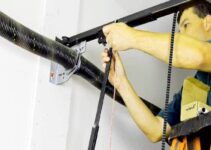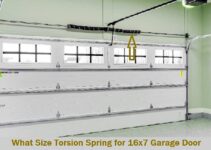Types of Garage Door Springs
Garage doors are an integral part of our homes, providing security and convenience. While they may seem like simple mechanisms, garage doors rely on a complex system of springs to ensure smooth operation.
In this article, we will learn the different types of garage door springs, how they work, signs of failure, maintenance tips, and important considerations for replacement.
Garage Door Springs

Garage door springs are crucial components that counterbalance the weight of the door and facilitate its movement.
These springs bear the load of the door, making it easier to open and close. There are four primary types of garage door springs: torsion springs and extension springs, torque master springs, and Clopay Ez-set torsion.
Different Types of Garage Door Springs
Torsion Springs
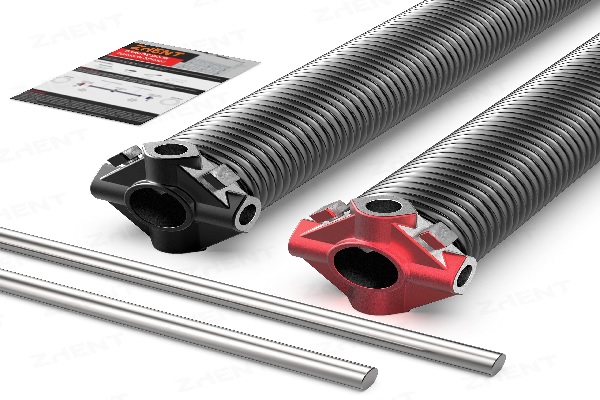
Torsion springs are a type of garage door spring that plays a vital role in counterbalancing the weight of the door. These springs are typically mounted horizontally above the door opening and work by twisting and storing energy when the door is lowered.
When the door is opened, the stored energy is released, helping to lift the door smoothly and with less effort. Torsion springs are known for their durability and better balance, making them a popular choice for modern garage doors.
Extension Springs
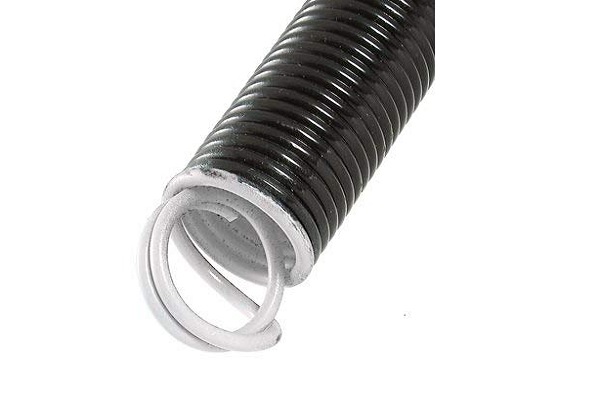
Extension springs are another type of garage door spring, commonly found in older garage door systems. These springs are typically mounted on both sides of the door tracks and work by extending and contracting to facilitate the door’s opening and closing.
When the door is closed, extension springs stretch, and when it’s opened, they recoil. Extension springs provide the necessary force to assist in the door’s movement. However, they have been gradually replaced by torsion springs due to safety concerns associated with their potential to snap and cause injuries.
TorqueMaster Spring

TorqueMaster spring is a specific type of garage door spring system manufactured by Wayne Dalton. It utilizes a unique design where the spring is enclosed inside a steel tube.
This design provides several advantages, including increased safety as the spring is shielded, improved aesthetics due to the streamlined appearance, and reduced risk of injury from spring-related accidents.
The TorqueMaster spring system is known for its smooth and quiet operation, making it a popular choice among homeowners.
Clopay EZ-Set Torsion
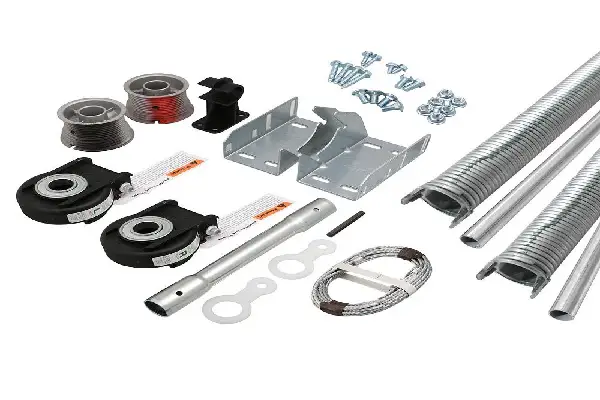
EZ-Set Torsion is a specific torsion spring system developed by Clopay, a leading manufacturer of garage doors. The EZ-Set system simplifies the installation and adjustment process of torsion springs, making it more convenient and user-friendly.
Unlike traditional torsion spring systems that require winding the springs manually, EZ-Set utilizes a proprietary mechanism that allows for easy adjustment with a drill. This system saves time and effort during installation and ensures accurate spring tensioning for optimal door performance.
Read Also: The Top 10 Most Expensive Garage Door Openers On The Market
Torsion Springs vs. Extension Springs:
- Function: Torsion springs work by twisting and storing energy, while extension springs extend and contract to assist in the door’s movement.
- Placement: Torsion springs are typically mounted horizontally above the door opening, whereas extension springs are mounted on the sides of the door tracks.
- Balance and Control: Torsion springs offer better balance and control compared to extension springs, resulting in smoother door operation.
- Safety: Torsion springs are generally considered safer than extension springs as they are less likely to snap and cause accidents. This is because torsion springs are enclosed and under less tension when the door is closed.
- Popularity: Torsion springs are more commonly used in modern garage doors due to their improved balance, control, and safety features, while extension springs are more often found in older garage door systems.
TorqueMaster Spring vs. Clopay EZ-Set Torsion:
- Design: TorqueMaster spring is designed with the spring enclosed inside a steel tube, providing added safety and a streamlined appearance. Clopay EZ-Set Torsion, on the other hand, focuses on simplifying the installation and adjustment process with a unique mechanism.
- Safety: The enclosed design of the TorqueMaster spring enhances safety by shielding the spring, reducing the risk of accidents and injuries. Clopay EZ-Set Torsion offers convenience and safety by allowing for easy adjustment using a drill, minimizing the need for manual winding and potential mishaps.
- Installation and Adjustment: TorqueMaster spring requires specialized knowledge and tools for installation and adjustment, often best performed by professionals. Clopay EZ-Set Torsion, as the name suggests, simplifies the installation process and provides an easier way to adjust spring tension, making it more user-friendly for homeowners.
- Operation: Both systems aim to provide smooth and efficient garage door operation. TorqueMaster spring focuses on a quiet and reliable operation, while Clopay EZ-Set Torsion streamlines the adjustment process to ensure proper spring tension and optimal door performance.
These differences highlight the various factors to consider when choosing between torsion springs and extension springs, as well as the unique features offered by the TorqueMaster Spring and Clopay EZ-Set Torsion systems. It’s important to assess your specific needs, budget, and safety preferences when deciding on the right type of garage door spring for your door.
Choosing the Right Garage Door Springs
When it comes to replacing your garage door springs, it’s important to choose the right type and specifications for your specific door. Factors to consider include:
- Door weight: The weight of your garage door plays a crucial role in determining the type and size of springs required for proper balancing.
- Spring lifespan: Different springs have varying lifespans. Consider the longevity and durability of the springs to minimize future replacements.
- Safety features: Look for springs that incorporate safety features such as containment cables to prevent injuries in case of spring failure.
- Professional advice: Consult with a garage door professional to ensure you select the appropriate springs for your specific door model and requirements.
Choosing the right springs is essential for the optimal performance and safety of your garage door.
What type spring is best for garage door?
When it comes to determining the best type of spring for a garage door, it depends on various factors such as the door’s weight, size, and the specific needs and preferences of the homeowner. Two commonly used types of springs for garage doors are torsion springs and extension springs.
Torsion springs are generally considered to be the better option for most modern garage doors. They are mounted horizontally above the door and operate by twisting and storing energy.
Torsion springs offer better balance, control, and durability compared to extension springs. They provide smoother door operation, require fewer maintenance efforts, and are considered safer as they are less likely to snap.
Conclusion
Garage door springs are essential components that enable the smooth and safe operation of your garage door.
The different types of springs, their functions, signs of failure, and the importance of regular maintenance is crucial for maintaining the longevity and performance of your garage door system.
When it comes to spring replacement, it’s best to rely on professional technicians to ensure the task is done safely and efficiently.
By following proper safety precautions and seeking expert guidance, you can enjoy a properly functioning garage door for years to come.
Related article
What Size Torsion Spring Do I Need?
Uncover the Secrets of Garage Door Spring Color Codes
Garage Door Torsion Spring Size Calculator
Winding Garage Door Springs: The Ultimate Guide
How to Measure Garage Door Torsion Springs: A Complete Guide
What Size Torsion Spring for 16×7 Garage Door
OMI 2.0 Torsion Spring: The Advancements in Garage Door Springs
Is Replacing a Garage Door Spring Dangerous?
How to Tell What Garage Door Spring I Need
